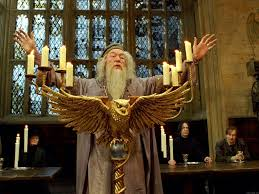I’m sure an English professor did his or her dissertation
on this topic, so you’ll forgive me if I miss some things. I recently finished
reading the Harry Potter series for the umpteenth time, and decided to
keep notes on details J.K. Rowling borrowed from J.R.R. Tolkien’s Lord of
the Rings, my second favorite series. Forgive me if I assume you’ve read
both series, or at least watched the movies, because I’m going to jump right in
with my comparisons.
Gandalf and Dumbledore are very much alike. They
mentor the main characters, the ‘chosen one’s but expect them to do extremely
dangerous tasks without giving them enough information. Both wizards die, or
appear to, but Gandalf comes back in book two and Dumbledore’s spirit offers
Harry advice in book seven.
While Frodo and Harry have similar characteristics –
both orphans, both courageous, both have loyal friends – Harry doesn’t actually
start his hero’s journey until book seven, when he must search for and destroy horcruxes,
while Frodo’s quest to destroy the One Ring is the main plot for all three LOTR
books. Oh, and Frodo is a Hobbit. There are no Hobbits at Hogwarts.
Both main characters are given a device to make them
invisible. The One Ring for Frodo and the Invisibility Cloak for Harry. Being
invisible does come in handy for our heroes, getting them out of many perilous
situations and allowing them to overhear crucial information.
The villains in the series are similar. Sauron and
Voldemort are both determined to be immortal. Perhaps the One Ring is a horcrux
containing Sauron’s soul. I suspect that’s where Rowling got the idea – destroy
the device, destroy the villain. Both villains are bloodthirsty, cruel, and
without bodies, at least until Voldemort gets a new one in book four.
There are also similarities in the villain’s henchmen.
Sauron has Orcs, Uruk-hai, and Nazgul at his command, with a Balrog thrown in to
challenge Gandalf. There is also one independent and complex villain called
Gollum. Perhaps Griphook the goblin is a type of Gollum, since he was
determined to have the sword of Gryffindor, offering to help Harry into
Gringotts, then betraying him to get the sword. That might be a stretch, but
you can see many examples of how Rowling borrowed Tolkein’s ideas and
characters, molding them to fit her own work.
Voldemort’s cronies include Death Eaters, Dementors, and
a vampire named Fenrir Greyback. Both authors used goblins, though in different
form, and both used a type of underwater zombies – Tolkien just called the zombie
realm the Dead Marsh, while Rowling called the creatures Inferi.
Both used elves, but in different forms. Tolkein’s beautiful,
wise, and immortal elves have little in common with Rowling’s house elves, except
that both can do unusual magic beyond the understanding of wizards.
Both authors used a scrying device – a basin of water
that allows the user to see past, present, and future events. Tolkien’s is
called the Mirror of Galadriel and Rowling’s is the Pensieve, although she also
introduced the Mirror of Erised in book one. The Pensieve was limited to
memories, but it was still an effective scrying device for Harry Potter. His one
glimpse into the future was through a crystal ball from Professor Trelawny’s
Divination class. Both authors also used prophecies to urge their characters
along on their quests.
Both authors used mountain trolls, dragons, ghosts, and
giant spiders to great effect. Living trees were also a device, although
Tolkein’s Ents were far more important to LOTR than Rowling’s single tree, the
Whomping Willow.
Rowling borrowed unapologetically from Tolkien’s
character names. Longbottom. Aragog (Aragorn). Wormtail (Wormtongue – both betrayed
their friends). In book three, she also borrowed a scene from Roald Dahl’s Charlie
and the Chocolate Factory when she blows up Aunt Marge like a giant beach
ball, similar to Violet Beauregarde who couldn’t resist chewing the forbidden gum,
but I digress. Let’s stick to Tolkien.
While she didn’t touch a few of Tolkien’s unique
ideas, such as Hobbits and Dwarves, a few fantastical creatures in Harry
Potter came straight from Rowling’s imagination. She even wrote a separate
book – and later a movie – to give them life (Fantastic Beasts and Where to
Find Them). For example, hippogriffs and thestrals are her own invention.
She also used merpeople, werewolves, vampires, giants, unicorns, centaurs, and
other creatures from classic fantasy to create her world.
Both authors used music and poetry, but a song in
Elvish – a real language Tolkien invented – is probably more impressive than a
ditty from the Sorting Hat. In conclusion, I don’t mind that Rowling borrowed
so heavily from LOTR. Clearly the books inspired her, and perhaps using some of
Tolkien’s devices in Harry Potter has encouraged others to read The
Hobbit and Lord of the Rings, and vise-versa. I do know that both authors
have my admiration for putting their vivid imaginations onto the written page
for all to enjoy.

